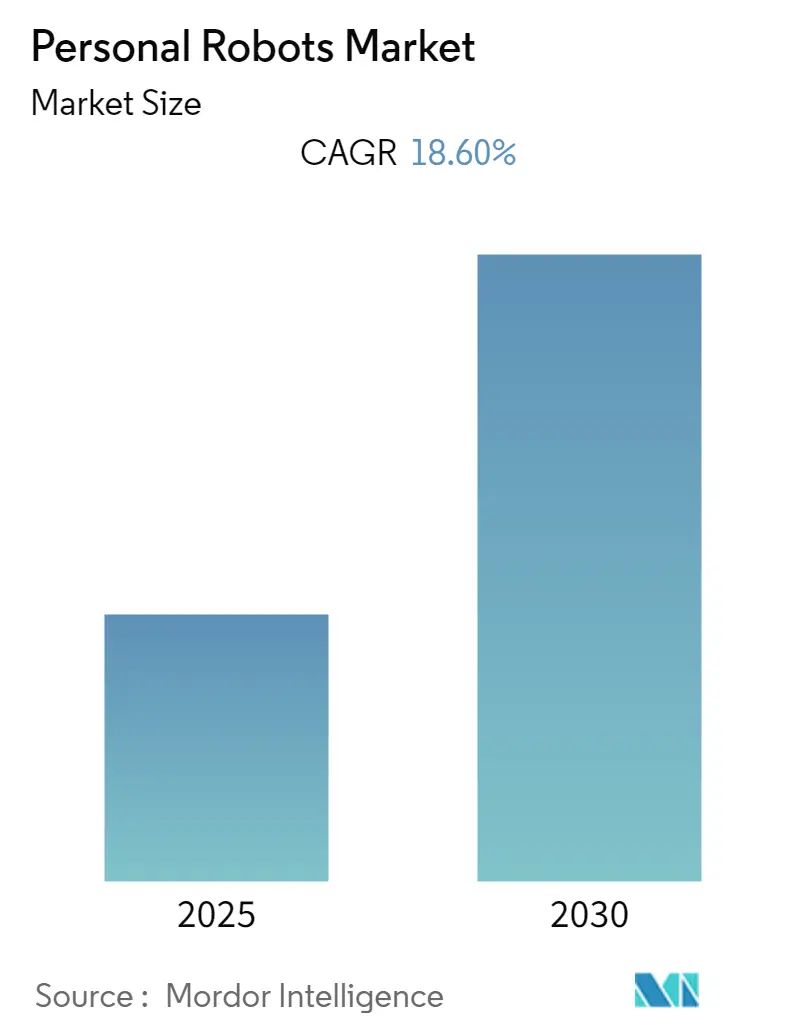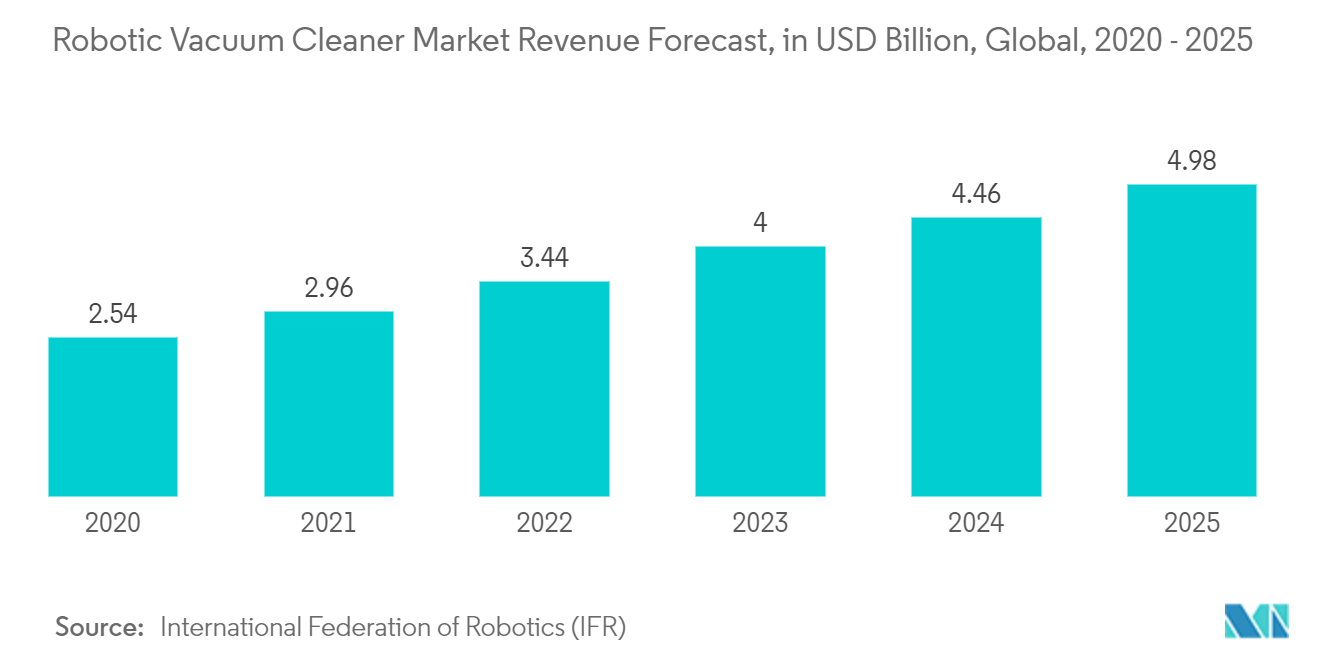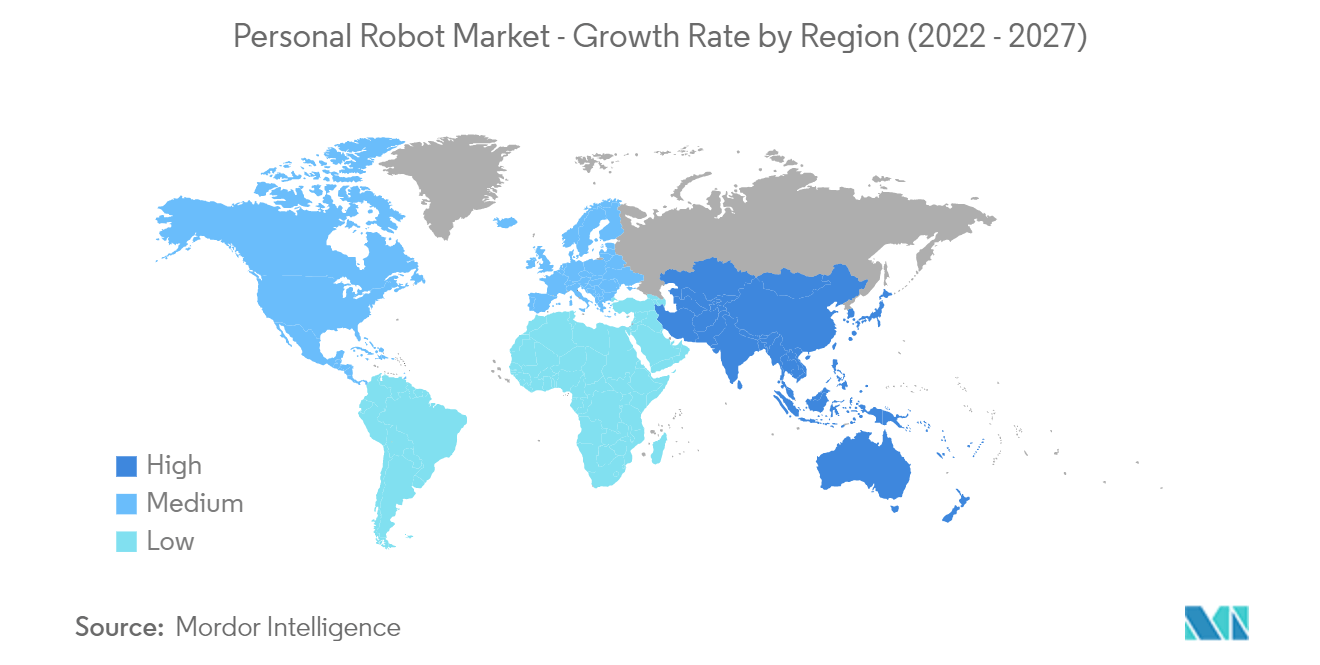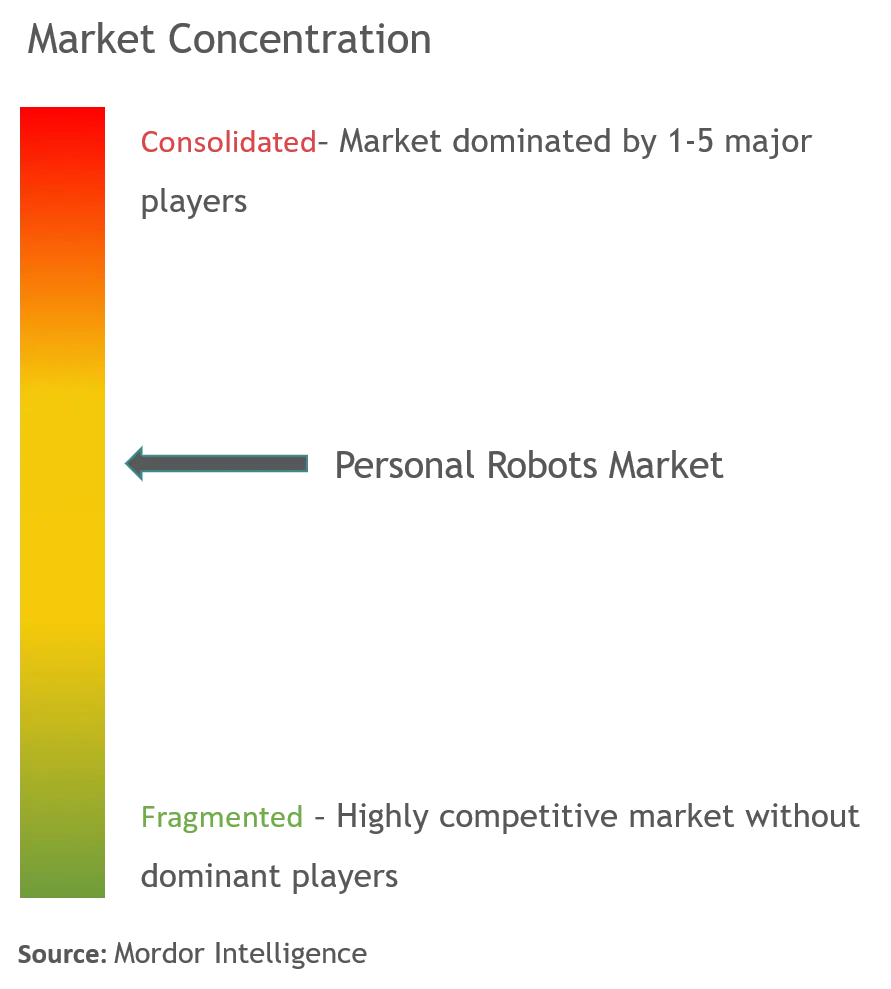
Personal Robots Market Analysis
The Personal Robots Market is expected to register a CAGR of 18.6% during the forecast period.
- The aging societies of the Asia-Pacific, like Japan and China, are driving growth in the medical technology sector, thus, creating a massive market for personal assistive robots in the region. According to the Statistics Bureau of Japan, the country's population (65 and over) is forecasted to grow from 36.39 million in 2021 to 39.21 million in 2040. This encourages companies to invest in products for the elderly in the region. One such robot that is already deployed is Paro (baby seal), designed to help patients with diseases like Alzheimer's.
- The technological innovations in various fields, such as cognition, interaction, and manipulation, make personal robots much more appealing. The technology and other component providers have been instrumental in driving the robotics ecosystem forward.
- Artificial intelligence (AI) technologies, including machine learning, computer vision, natural language processing, and gesture controls, are transforming how personal robots are deployed in homes and hospitals. As personal robots become more intelligent, they will be capable of comprehending their surroundings, avoiding static and dynamic objects, comprehending emotions, and communicating, allowing them to move around in congested and congested spaces like homes.
- Additionally, with the increasing developments in machine vision cameras, companies are using these 2D and 3D machine vision cameras with AI technologies to effectively map the edges of the floor, such as a staircase, and recognize obstacles, such as dustbins and cables, doorsills, and rugs which are expected to pave the way for next-generation robots.
- However, the lack of personal robot technology standardization, technical complexity associated with operating these robots, along with complications in the integration of these systems across various use cases are some of the major factors challenging the growth of the personal robots market.
- The coronavirus pandemic caused havoc in the manufacturing and technology industries. Several global and regional players in the robotics sector witnessed severe component and raw material shortages, which had a direct impact on their offerings. The worldwide supply chain network got disrupted by the nationwide lockdown in most nations, resulting in a drop in product sales.
- Moreover, due to the growing interest in robotic technologies, companies like ABB and Rockwell Automation have seen their stock values rise during the COVID-19 pandemic. In 2020, ForwardXRobotics recently announced USD 15 million in funding to expand into the North American market, while Brain Corp has experienced increasing demand for its floor-cleaning robots, especially among enterprises under closure orders for the previous few weeks.
- Such trends have had a negative impact on the growth of the studied market; however, with the awareness about advanced technologies growing within a larger section of the audience, especially since the outbreak of the pandemic, the long-term impact on the growth of the studied market is expected to be positive.
Personal Robots Market Trends
Personal Robots for Household Work is Expected to Hold a Major Share of the Market
- Robot companions/assistants/humanoids, vacuuming, floor cleaning, lawn mowing, pool cleaning, and window cleaning, among others, are some of the major types of robots that are increasingly gaining popularity in the household segment of personal robots. According to the data provided by the International Federation of Robotics (IFR) and Loup Ventures, about 22.1 million robotic vacuum cleaners are expected to be shipped by 2025, generating a revenue of approximately USD 4.98 billion.
- Among all the household robots, automated vacuum cleaners and moppers are the companies' most commercialized and developed products. The companies are continuously investing in developing more compact and integrated vacuum cleaners and mopping robots to reach little places at home. The companies are integrating advanced technologies like voice recognition and laser-based technologies to map the floor structure. For instance, in February 2022, Midea Group, a leading global high-technology company, announced details of Midea's S8+ auto-dust-collection robot, its next-gen robot vacuum cleaner, made by Midea Robozone Technology, one of its subsidiaries.
- Companies like iRobot, Robomow, and Mayfield Robotics, are among the prominent players, innovating robots for household space. Innovations, like detecting human behavior and voice recognition, are increasing customer confidence, thus, driving the automated deployment for household purposes, like cleaning, laundry, and other voice-enabled IoT activities.
- Additionally, with the increasing developments in machine vision cameras, companies are also using these 2D and 3D machine vision cameras with AI technologies to map and edges of the floor like staircases effectively and to recognize obstacles such as cables, dustbins, doorsills, and rugs. Incorporating technologies like machine learning, AI, and facial recognition, are also bringing innovations into household robots. For instance, in February 2019, CloudMinds Technology, a developer and operator of cloud AI and robotic solutions, launched its cloud AI-based, highly compliant service robot, the XR-1.

Asia Pacific to Hold Significant Market Share
- The aging population is a primary factor for the significant growth in the deployment of robots in domestic healthcare and assistance applications in the region. The Japanese government has announced funding for the development of eldercare robots to fill the estimated gap of 380,000 skilled workers by 2025. This is expected to drive the adoption of elderly care robots also at their residences in the recent future.
- Robotic wheelchairs are also gaining attraction in the region. Companies like Panasonic are increasingly making efforts to develop innovative wheelchairs that can fulfill different use cases. For instance, in February 2021, All Nippon Airways (ANA) Japan and Panasonic Corporation entered a partnership to test self-driving electric wheelchairs. The collaboration is part of a far-reaching plan to increase mobility and accessibility options at Tokyo Narita International Airport.
- China is expected to become the leading country in terms of personal robot adoption as the country has been making significant efforts lately to become a global leader in the field of robotics. For instance, in December 2021, China's Ministry of Industry and Information Technology, in collaboration with 14 other government departments, unveiled its plans to grow the country's robotics industry in its 14th five-year plan.
- The growing 5G penetration in countries like India is also expected to help push the deployment of security and surveillance robots as the residents can access the data on the go. Countries like India are expected to speed up the deployment of 5G in the coming years, which is expected to create a favorable market scenario for the personal robots market.
- Moreover, APAC is likely to adopt humanoids for almost all major applications. Humanoids are anticipated to be used in personal support and caregiving applications in APAC countries such as China and Japan as the senior population grows.

Personal Robots Industry Overview
The competitive landscape of the personal robotic market remains exceptionally dynamic. Several startups are entering the market to meet emerging customer needs for various applications. Some of the major players operating in the market include Sony Corporation, Honda Motor Company Ltd., iRobot Corporation, Ecovacs Robotics Inc., etc. Some of the recent developments in the market are as follows:-
- August 2022 - Amazon.com Inc announced the acquisition of iRobot Corp, the maker of robot vacuum cleaners, in an all-cash deal for about USD 1.7 billion. Through this acquisition, the company focuses on further expanding its presence in the personal robots and smart home devices market.
- May 2022 - iRobot Corp., a leader in consumer robots, introduced iRobot OS, an evolution of the company's Genius Home Intelligence platform. iRobot OS delivers a new customer experience for a healthier, cleaner, and smarter home. The new iRobot OS enables the robots to get smarter, delivering valuable new features and functionality that benefit all customers.
Personal Robots Market Leaders
-
Sony Corporation
-
Honda Motor Company, Ltd.
-
Ecovacs Robotics Inc.
-
iRobot Corporation
-
Samsung Group
- *Disclaimer: Major Players sorted in no particular order
Personal Robots Market News
- January 2022 - ECOVACS, a service robotics company, unveiled its market-changing DEEBOT X1 cleaning robots at CES 2022. With fully automated and ultra-premium robotic vacuum & mop cleaning systems. The product offers an all-in-one solution with the ultimate goal of a cultural shift away from in-home, hands-on work to a truly hands-free and consistent cleaning experience.
- January 2021 - Samsung Electronics Co., Ltd. introduced the new JetBot 90 AI+ that features smart technologies. The product is designed to optimize its cleaning route and respond to its environment. The new robot uses a 3D sensor to recognize the difference between objects such as a toy and the leg of a chair; the sensor also enables it to detect even small objects on the floor and recognizes a room's shape to maneuver around it.
Personal Robots Industry Segmentation
Personal robots are designed for personal activities like household work, education, entertainment, and education. Its design and human interface make it useful for individuals. The market studied has been segmented based on the types of personal robots and geography. The study includes a comprehensive analysis of the personal robots market based on several aspects, such as demand and supply, technological trends, susceptibility to innovation, and future growth prospects. The study also includes a detailed analysis of COVID-19 impact on the personal robots market.
| By Type | Household Work |
| Entertainment | |
| Elderly and Handicap Assistance | |
| Home Security and Surveillance | |
| Other type | |
| By Geography | North America |
| Europe | |
| Asia-Pacific | |
| Rest of the World |
Personal Robots Market Research FAQs
What is the current Personal Robots Market size?
The Personal Robots Market is projected to register a CAGR of 18.6% during the forecast period (2025-2030)
Who are the key players in Personal Robots Market?
Sony Corporation, Honda Motor Company, Ltd., Ecovacs Robotics Inc., iRobot Corporation and Samsung Group are the major companies operating in the Personal Robots Market.
Which is the fastest growing region in Personal Robots Market?
Asia Pacific is estimated to grow at the highest CAGR over the forecast period (2025-2030).
Which region has the biggest share in Personal Robots Market?
In 2025, the North America accounts for the largest market share in Personal Robots Market.
What years does this Personal Robots Market cover?
The report covers the Personal Robots Market historical market size for years: 2019, 2020, 2021, 2022, 2023 and 2024. The report also forecasts the Personal Robots Market size for years: 2025, 2026, 2027, 2028, 2029 and 2030.
Our Best Selling Reports
Personal Robots Industry Report
Statistics for the 2025 Personal Robots market share, size and revenue growth rate, created by Mordor Intelligence™ Industry Reports. Personal Robots analysis includes a market forecast outlook for 2025 to 2030 and historical overview. Get a sample of this industry analysis as a free report PDF download.

.webp)


